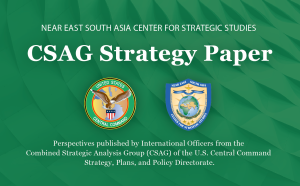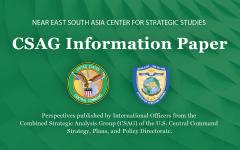CSAG Strategy Paper: Ceasefire Part 3 – Where is the Exit?
August 7, 2025 2025-08-07 20:51CSAG Strategy Paper: Ceasefire Part 3 – Where is the Exit?
CSAG Strategy Paper: Ceasefire Part 3 – Where is the Exit?
CSAG STRATEGY PAPER
Ms. Sanna Stark (CF4), SWE Armed Forces (CSAG/CCJ5)
28 July 2025

Introduction:
The war in Gaza is well into its second year, without significant progress toward a resolution, despite substantial efforts from mediators and the international community. Negotiations intensified toward the end of 2024, and on January 19, 2025, an initial phase of a ceasefire was implemented. While the first phase largely followed the terms of the agreement, the deal ultimately collapsed due to failed negotiations on the more challenging second phase, leading to an immediate return of Israeli strikes. Israel has since March 18, 2025, when the ceasefire broke down, clarified their aim to take complete military control of the Gaza Strip.
Over the past years, CSAG has closely monitored the conflict, publishing a series of strategy papers on the ceasefire and two additional papers addressing the Palestinian issue in general, offering a balanced perspective to understand the historical conflict and assess the different stakes involved.[i] To provide a comprehensive view on the current situation, the analysis in this third paper in the Ceasefire-series has been divided into two parts. The first part assesses the war through three different lenses; “conflict ripeness”, exit strategy, and negotiation/mediation strategy. The second part highlights four different scenarios, with different benefits and risks, to provide an analysis of the most plausible way forward. This paper examines the prospects for a lasting ceasefire/cessation of hostilities and the most likely path for the future of Gaza given the current conditions.
Key Points:
- The most likely option for Gaza moving forward given current conditions is permanent Israeli occupation and displacement of the Palestinian people on the Strip.
- Israel has not achieved the initial war aims, and mission creep is setting in where control of Gaza is now only a smaller part of a larger strategy, aiming to completely alter the dynamics in the Middle East for its own purposes. Israel’s exit strategy from the war In Gaza is now a de facto entanglement.
- Hamas still constitutes a threat, although not an existential threat to Israel. However, permanent occupation to contain the threat will likely result in severe regional challenges for Israel in the longer term and new strategic issues due to the severity of the humanitarian situation and the lack of resolution or an acceptable solution for the Palestinians.
- This could also become a major problem for the U.S., as they seek to balance the relationship with Mideast partners and the broader international community, with that of their longtime ally Israel.
- Supporting and reframing the Egyptian/Arab League Plan would be beneficial for conflict resolution, as it carries similarities to the President’s proposal for Gaza without displacing civilians or exposing the U.S. to further international tensions.
- If the situation continues to evolve in the current direction, it will likely result in new wide-ranging strategic issues that would have to be dealt with by USCENTCOM. This could end up creating further resource competition between focus on the Middle East and the Indo-Pacific Area.
- This risk will increase significantly if Israel acts in a manner that results in pushing Palestinian refugees toward Jordan and Egypt, bringing with it further regional tensions and potentially widening of armed conflict.
View other USCENTCOM Combined Strategic Analysis Group (CSAG) papers here.
The opinions and conclusions expressed herein are those of a number of international officers within the Combined Strategic Analysis Group (CSAG) and do not necessarily reflect the views of United States Central Command, not of the nations represented within the CSAG or any other governmental agency.



